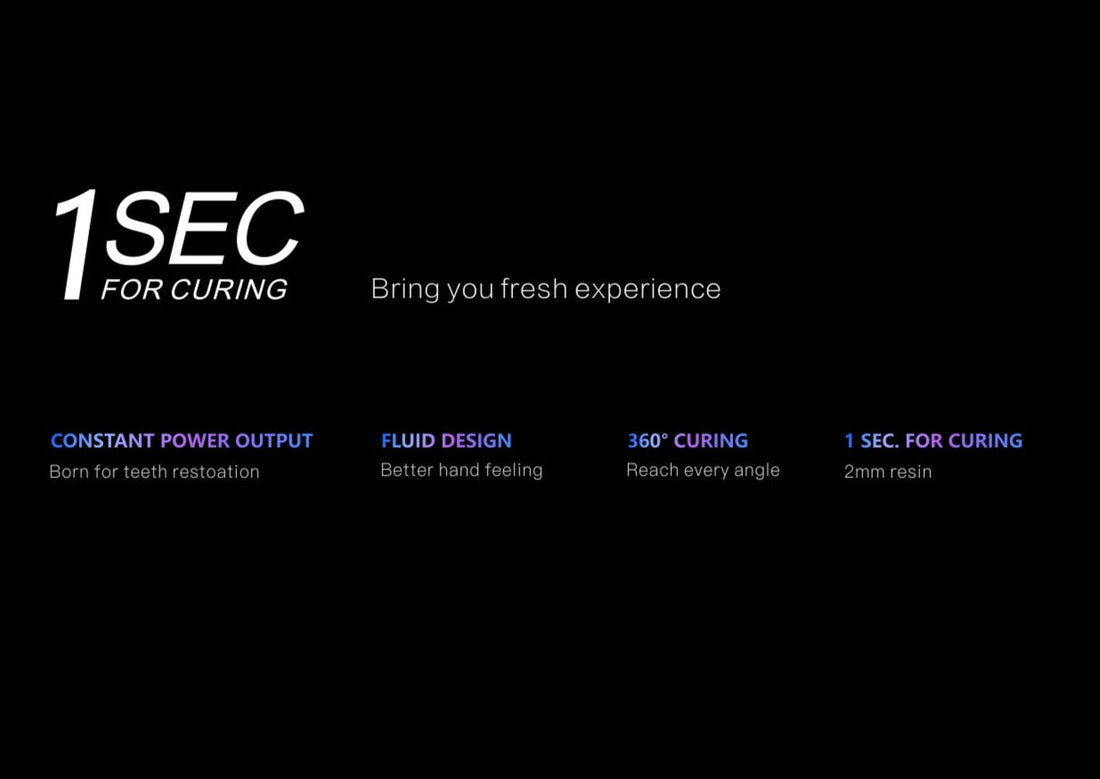
Is 1-Second Dental Curing Safe and Effective?
Share
1-Second Curing: Is It Really Safe and Effective?
Dental technology is evolving — and fast. With the introduction of high-powered 1-second curing lights, many dentists are intrigued but cautious. Can a restoration truly cure in just one second? Is it safe for the material… and the patient?
In this article, we’ll break down the science, safety, and clinical effectiveness of 1-second curing using advanced tools like the Woodpecker iLED, so you can decide whether it's right for your practice.
What Is 1-Second Curing?
Traditional curing lights often require 10–20 seconds to polymerize each layer of composite resin. New-generation devices like the Woodpecker iLED boast ultra-high power (up to 2400 mW/cm²) and dual-wavelength LEDs to cure compatible materials in just 1–3 seconds.
The idea is simple: More power = faster polymerization, without compromising depth or strength.
Is It Really Safe?
Yes — when used properly and on suitable materials.
1. Backed by Research
Studies have shown that high-intensity, short-duration curing can be just as effective — if not more — than conventional methods, as long as the energy density is appropriate.
2. Material Compatibility
Not all composites are designed for ultra-fast curing. Check manufacturer recommendations — bulk-fill or fast-cure composites tend to perform best.
3. Smart Technology Enhances Safety
Devices like the Woodpecker iLED are equipped with:
-Heat control systems to prevent overheating
-Precision timing modes (1s, 3s, 5s, etc.)
-Automatic intensity regulation to protect soft tissue and the pulp
4. Less Heat, More Comfort
Surprisingly, short bursts of high light intensity may generate less overall heat than prolonged exposure to lower-intensity lights. That means more comfort for your patients.
Is It Clinically Effective?
Absolutely — when used correctly.
Deep and even curing: The iLED uses dual wavelengths (385–515 nm) to cure a wide range of composites, ensuring better depth and adhesion.
No tacky surfaces: Properly cured layers are hard, smooth, and polishable.
Reduced microleakage: High polymerization efficiency helps minimize shrinkage and marginal gaps.
Dentists using the iLED report consistent clinical results, less post-op sensitivity, and increased confidence in fast restorative procedures.
Why Dentists Are Making the Switch?
Time-saving: Imagine saving 5–10 minutes per restoration — it adds up quickly.
Improved workflow: Quicker procedures mean more patients, or more time for each one.
Modern edge: Fast-curing tools position your clinic as innovative and high-tech.
How to Implement 1-Second Curing in Your Practice?
1. Choose the right light: Ensure it offers enough power, multiple curing modes, and wavelength versatility.
2. Test your materials: Check if your go-to composites are compatible.
3. Train your team: Proper technique matters — especially angling, distance, and timing.
Final Thoughts:
1-second curing isn’t just a gimmick — it’s a clinically proven, research-backed advancement in modern restorative dentistry. With a device like the Woodpecker iLED, you can embrace faster, safer, and more effective treatment protocols without compromising quality or safety.
See It in Action
Explore the Woodpecker iLED Curing Light — and experience the power of 1-second dentistry.
Discover more about ILED curing light
Author Bio :
Dr. Rami Mousattat is the CEO of Dental Solutions and a former periodontist and trainer with extensive experience in the field of dental implants. With a career spanning several countries, Dr. Mousattat has trained numerous dentists in advanced techniques and continues to champion innovation and excellence in dental care.
